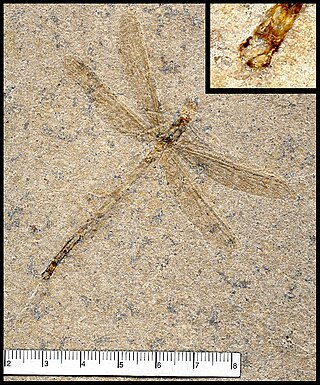| Genera of Aeschnidiid dragonfly |
|---|
| Generic name | Geographical location | Age |
|---|
| † Aegyptidium [2] | Abu Ballas Formation, Egypt | 122-112 Ma, Early Cretaceous |
| † Aeschnidiella [2] | Ulyanovsk Oblast, Russia | 125-113 Ma, Early Cretaceous |
| † Aeschnidiopsis [2] | Walumbilla Formation, Australia | 125-113 Ma, Early Cretaceous |
| † Aeschnidium [2] | Lulworth Formation, England | 145-140 Ma, Early Cretaceous |
| † Angloaeschnidium [2] | La Huérguina Formation, Spain, and the Weald Clay Formation, England | 130-125 Ma, Early Cretaceous |
| † Bergeriaeschnidia [2] | Solnhofen Limestone, Germany | 151-145 Ma, Late Jurassic |
| † Brunetaeschnidium [2] | Nusplingen Limestone, Germany and the Solnhofen Limestone, Germany | 156-145 Ma, Late Jurassic |
| † Brunneaeschnidia [3] | Chijinbao Formation, China | 125-113 Ma, Early Cretaceous |
| † Cooperaeschnidium [2] | Weald Clay Formation, England | 130-125.45 Ma, Early Cretaceous |
| † Coramaeschnidium [2] | Weald Clay Formation, England | 136.4-130 Ma, Early Cretaceous |
| † Cratoaeschnidium [4] | Crato Formation, Brazil | 115-113 Ma, Early Cretaceous |
| † Dakotaeschnidium [5] | Fox Hills Formation, The United States of America | 70.6-66 Ma, Late Cretaceous |
| † Deiciosaeschidium [2] | Purbeck-Lulworth Formation, England | 145-140 Ma, Early Cretaceous |
| † Diastatopaeschnidium [2] | Purbeck-Lulworth Formation, England | 145-140 Ma, Early Cretaceous |
| † Dracontaeschnidium [2] | Yixian Formation, China | 125-122 Ma, Early Cretaceous |
| † Gansuaeschnidia [6] | Chijinbao Formation, China | 125-113 Ma, Early Cretaceous |
| † Gigantoaeschnidium [2] | La Huérguina Formation, Spain | 130-125 Ma, Early Cretaceous |
| † Iberoaeschnidium [2] | La Huérguina Formation, Spain | 130-125 Ma, Early Cretaceous |
| † Jarzembowskiaeschnidium [2] | Purbeck-Lulworth Formation, England | 145-140 Ma, Early Cretaceous |
| † Kesseleraeschnidium [2] | Weald Clay Formation, England | 136-130 Ma, Early Cretaceous |
| † Kimmeridgebrachpteraeschnidium [2] | Kimmeridge Clay Formation, England | 156-151 Ma, Jurassic |
| † Leptaeschnidium [2] | Zaza Formation, Russia | 125-113 Ma, Early Cretaceous |
| † Linaeschnidium [1] | Yixian Formation, China | 125-122 Ma, Early Cretaceous |
| † Lithoaeschnidium [2] | Solnhofen Limestone, Germany | 151-145 Ma, Late Jurassic |
| † Lleidoaeschnidium [2] | La Pedrera de Rubies Formation, Spain and the Weald Clay Formation, England | 130-125 Ma, Early Cretaceous |
| † Malmaeschnidium [2] | Solnhofen Limestone, Germany | 151-145 Ma, Late Jurassic |
| † Misofaeschnidium [2] | Nusplingen Limestone, Germany and the Solnhofen Limestone, Germany | 156-145 Ma, Late Jurassic |
| † Nannoaeschnidium [2] | La Huérguina Formation, Spain | 130-125 Ma, Early Cretaceous |
| † Rossaeschnidium [2] | Weald Clay Formation, England | 130-125 Ma, Early Cretaceous |
| † Santanoptera [7] | Crato Formation, Brazil | 122-112 Ma, Early Cretaceous |
| † Sinaeschnidia [2] | Hangjiahu Formation, China, the Laiyang Formation, China, the Baiwan Formation, China, the Yixian Formation, China, the Shahai Formation, China, the Chijinbao Formation, China, and the La Huérguina Formation, Spain | 130-113 Ma, Early Cretaceous |
| † Sinostenophlebia [8] | Qingshila Formation, China | 129-125 Ma, Early Cretaceous |
| † Solnhofenia [2] | Solnhofen Limestone, Germany | 151-145 Ma, Late Jurassic |
| † Stylaeschnidium [2] | Yixian Formation, China | 125-122 Ma, Early Cretaceous |
| † Tauropteryx [2] | Crimea, Ukraine | 99.6-93.5 Ma, Late Cretaceous |
| † Urogomphus ? [2] | Solnhofen Limestone, Germany and the Purbeck-Lulworth Formation, England | 151-140 Ma, Late Jurassic to Early Cretaceous |
| † Wightonia [7] | Crato Formation, Brazil | 122-112 Ma, Early Cretaceous |
| † Spinofaarus rexyjponetwothree [2] | Baharian Formation, China | 125-122 Ma, Early Cretaceous |
|








